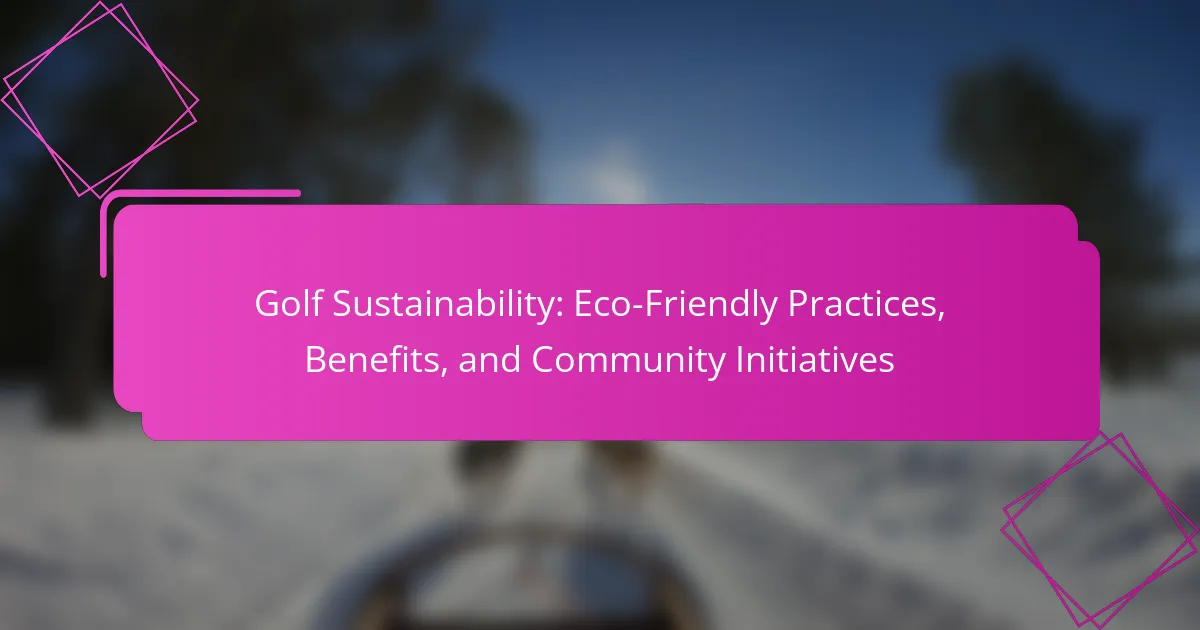Golf sustainability focuses on eco-friendly practices that benefit the environment and engage communities. Key practices include water conservation, organic landscaping, and energy-efficient operations. The article explores the environmental benefits of these practices, highlights community initiatives that promote sustainability, and addresses the challenges faced in implementing these strategies across different regions. Emerging trends in technology and innovative solutions are also examined, showcasing the evolving commitment to sustainability in the sport.
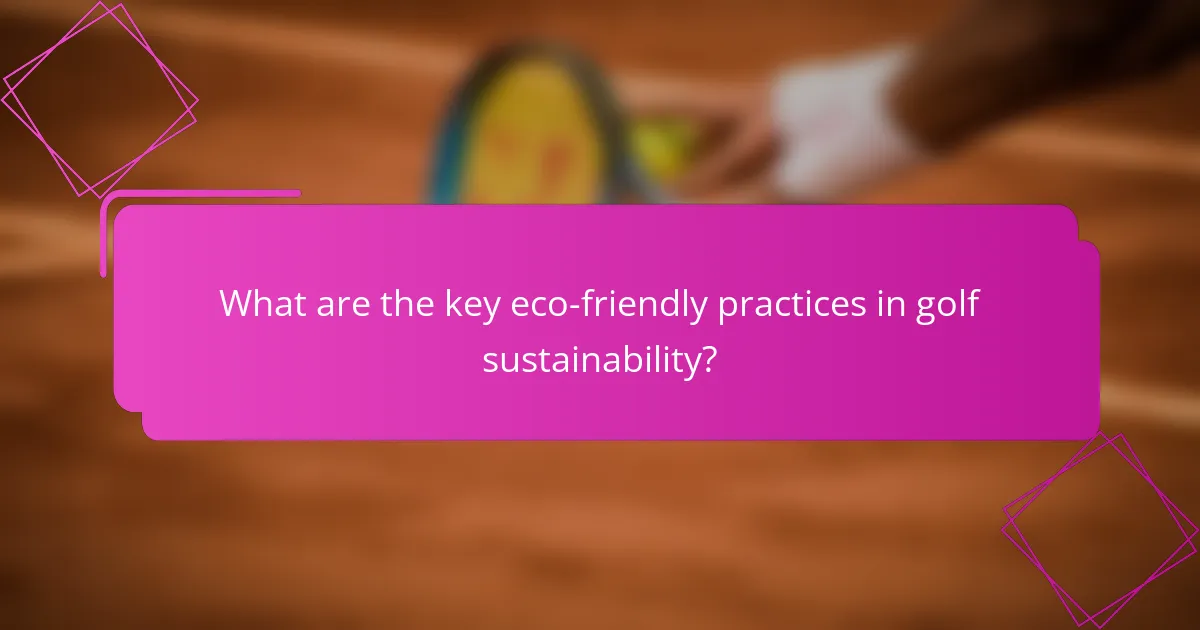
What are the key eco-friendly practices in golf sustainability?
Key eco-friendly practices in golf sustainability include water conservation, organic landscaping, and energy-efficient operations. These practices enhance the environment while promoting community engagement. For example, many courses utilize rainwater harvesting systems to reduce water usage. Additionally, using native plants minimizes chemical inputs and supports local ecosystems. Implementing solar energy solutions can significantly lower carbon footprints, showcasing the commitment to sustainability in golf.
How does water conservation impact golf course management?
Water conservation significantly enhances golf course management by optimizing resource use and promoting sustainability. Effective water management practices lead to healthier turf and reduced operational costs. For instance, adopting drought-resistant grass varieties can decrease water consumption by up to 50%. Additionally, implementing rainwater harvesting systems supports irrigation needs, further minimizing reliance on municipal water sources. These eco-friendly initiatives not only benefit the environment but also improve the course’s reputation within the community, attracting environmentally conscious golfers.
Which sustainable materials are used in golf course construction?
Sustainable materials used in golf course construction include recycled water, native grasses, and permeable paving. These materials enhance environmental stewardship and reduce resource consumption. Recycled water minimizes freshwater use, native grasses require less maintenance and irrigation, and permeable paving supports natural drainage. Employing these materials promotes ecological balance and sustainability in golf course design.
What role does organic landscaping play in golf sustainability?
Organic landscaping significantly enhances golf sustainability by promoting biodiversity and reducing chemical use. This practice involves using native plants and sustainable maintenance techniques, which can lead to healthier ecosystems. Additionally, organic methods minimize water consumption and improve soil health, contributing to overall environmental resilience. By adopting organic landscaping, golf courses can align with community initiatives aimed at ecological preservation and attract environmentally conscious players.
How can renewable energy be integrated into golf facilities?
Renewable energy can be effectively integrated into golf facilities by utilizing solar panels, wind turbines, and geothermal systems. These solutions reduce energy costs and minimize environmental impact.
Solar panels can be installed on rooftops or parking areas, generating electricity for course maintenance and clubhouse operations. Wind turbines can complement solar energy, especially in open areas, providing additional power. Geothermal systems can be used for heating and cooling, enhancing energy efficiency.
Implementing these technologies not only lowers carbon footprints but also promotes sustainability within the golfing community. Facilities can attract eco-conscious players and enhance their reputation as environmentally responsible venues.

What benefits does golf sustainability offer to the environment?
Golf sustainability offers significant environmental benefits by promoting biodiversity, conserving water, and reducing chemical usage. Eco-friendly practices help maintain healthy ecosystems and improve air quality. For example, sustainable golf courses often incorporate native plants, which support local wildlife and require less maintenance. Additionally, initiatives aimed at reducing carbon footprints contribute to climate change mitigation. Overall, these practices create a healthier environment for both golfers and surrounding communities.
How does sustainable golf contribute to biodiversity?
Sustainable golf enhances biodiversity by implementing eco-friendly practices that protect natural habitats. These initiatives include creating wildlife corridors, using native plants, and reducing chemical inputs. For example, golf courses that prioritize organic maintenance methods can support diverse ecosystems. As a result, sustainable golf fosters healthier environments for various species while promoting community awareness and engagement in conservation efforts.
What are the economic advantages of adopting eco-friendly practices in golf?
Adopting eco-friendly practices in golf offers significant economic advantages. These practices can reduce operational costs, attract environmentally conscious consumers, and enhance brand reputation.
Sustainable practices often lead to lower water and energy usage, resulting in reduced utility bills. For example, using drought-resistant grass can decrease irrigation costs significantly.
Furthermore, golf courses that implement eco-friendly initiatives may qualify for tax incentives and grants, providing financial support for sustainability projects.
In addition, the growing interest in sustainable tourism means that eco-friendly golf courses can attract more visitors, boosting revenue and community engagement.
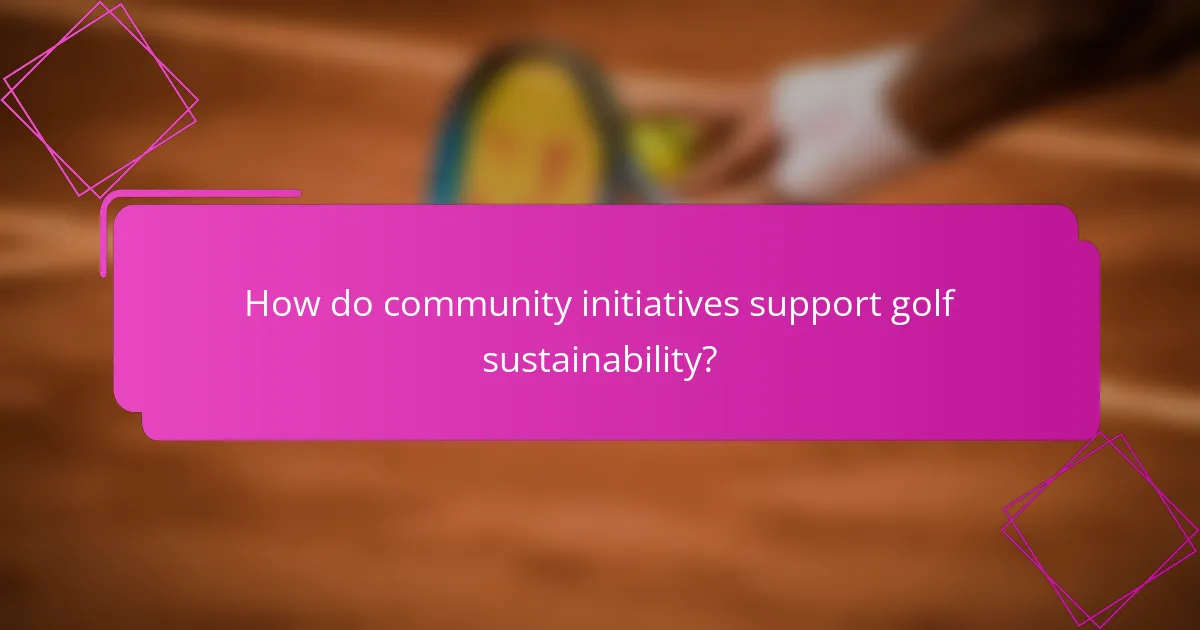
How do community initiatives support golf sustainability?
Community initiatives significantly enhance golf sustainability by promoting eco-friendly practices and fostering local engagement. These initiatives often include tree planting, water conservation efforts, and habitat restoration projects. They help reduce the environmental impact of golf courses while encouraging community involvement. For example, many golf clubs collaborate with local schools to educate young players about sustainability. This approach not only supports the environment but also cultivates a sense of responsibility among future generations. As a result, community initiatives play a crucial role in maintaining the ecological balance while ensuring the longevity of the sport.
Which organizations promote environmental stewardship in golf?
Several organizations promote environmental stewardship in golf, focusing on sustainable practices. Notable entities include the Golf Environment Organization, which provides guidance on eco-friendly initiatives, and Audubon International, known for its certification programs that encourage wildlife conservation on golf courses. The United States Golf Association also supports sustainability efforts through research and education. Additionally, the R&A promotes environmental awareness globally, emphasizing the importance of preserving natural resources in the sport. These organizations collectively enhance the ecological impact of golf through various community initiatives and best practice guidelines.
How can local communities engage with sustainable golf practices?
Local communities can engage with sustainable golf practices by implementing eco-friendly initiatives that promote environmental stewardship. These practices include using organic fertilizers, conserving water, and preserving natural habitats. Community involvement can enhance awareness and participation in sustainability efforts, leading to healthier ecosystems and improved local biodiversity. Initiatives like tree planting events and educational workshops can also foster a sense of ownership and responsibility among residents. As a result, these actions not only benefit the golf courses but also contribute positively to the surrounding environment and community well-being.
What educational programs exist to raise awareness about golf sustainability?
Various educational programs promote golf sustainability, focusing on eco-friendly practices and community engagement. Organizations like the Golf Environment Organization provide resources and training for sustainable course management. Additionally, initiatives such as the Audubon Cooperative Sanctuary Program educate clubs on environmental stewardship. Workshops and seminars often highlight best practices in water conservation and habitat preservation. Programs aimed at youth, like First Tee, incorporate sustainability into their curriculum, fostering a new generation of environmentally conscious golfers.
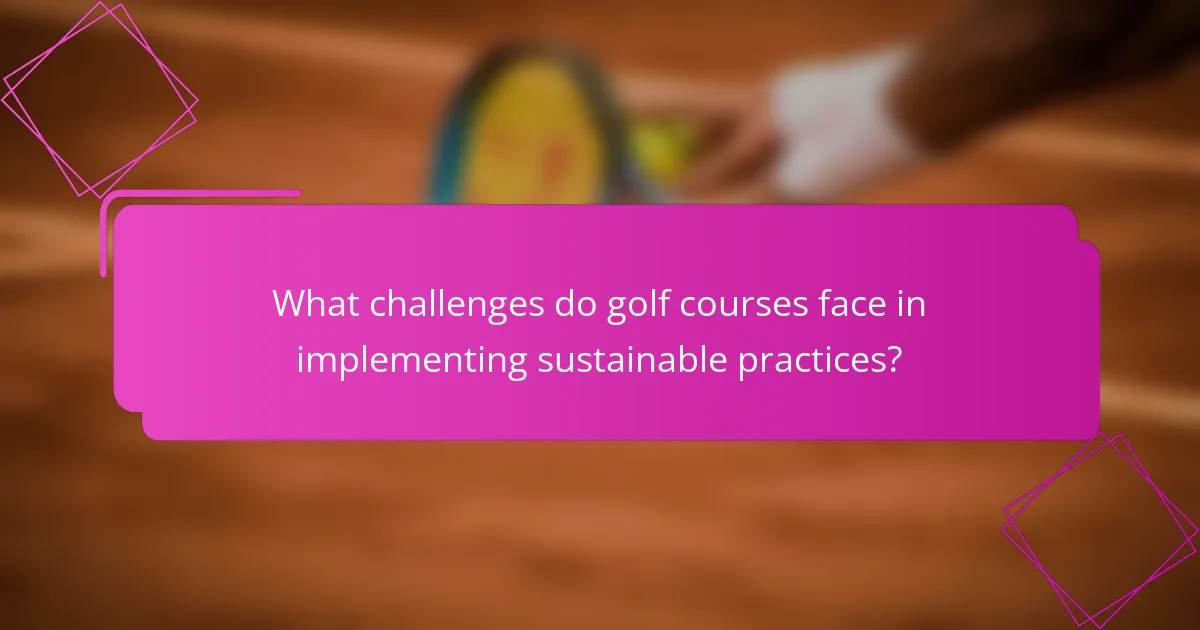
What challenges do golf courses face in implementing sustainable practices?
Golf courses face significant challenges in implementing sustainable practices, including financial constraints, water management issues, and resistance to change. Financially, the high costs of eco-friendly technologies and practices can deter investment. Water management is critical, as golf courses often require substantial water resources, which can be unsustainable in drought-prone areas. Additionally, some stakeholders may resist changes due to a lack of understanding or perceived threat to the traditional golfing experience. These challenges hinder the adoption of sustainable practices that could benefit both the environment and the community.
How do climate change and extreme weather affect golf sustainability efforts?
Climate change and extreme weather significantly hinder golf sustainability efforts by disrupting course maintenance and water resources. Increased temperatures and unpredictable rainfall patterns can lead to drought conditions, affecting turf health. Additionally, extreme weather events can damage infrastructure, necessitating costly repairs and impacting community initiatives. Adapting to these challenges requires innovative eco-friendly practices that promote resilience in golf course management.
What are the common misconceptions about golf course sustainability?
Common misconceptions about golf course sustainability include the belief that maintaining a golf course is inherently harmful to the environment. Many think that chemical use is excessive, while in reality, sustainable practices often minimize chemical inputs. Another misconception is that golf courses consume excessive water, but modern irrigation technologies promote efficient water use. Additionally, some believe that golf courses cannot coexist with wildlife, yet many courses enhance biodiversity through habitat preservation. Lastly, people often underestimate the community benefits of golf course sustainability initiatives, which can foster local engagement and environmental education.
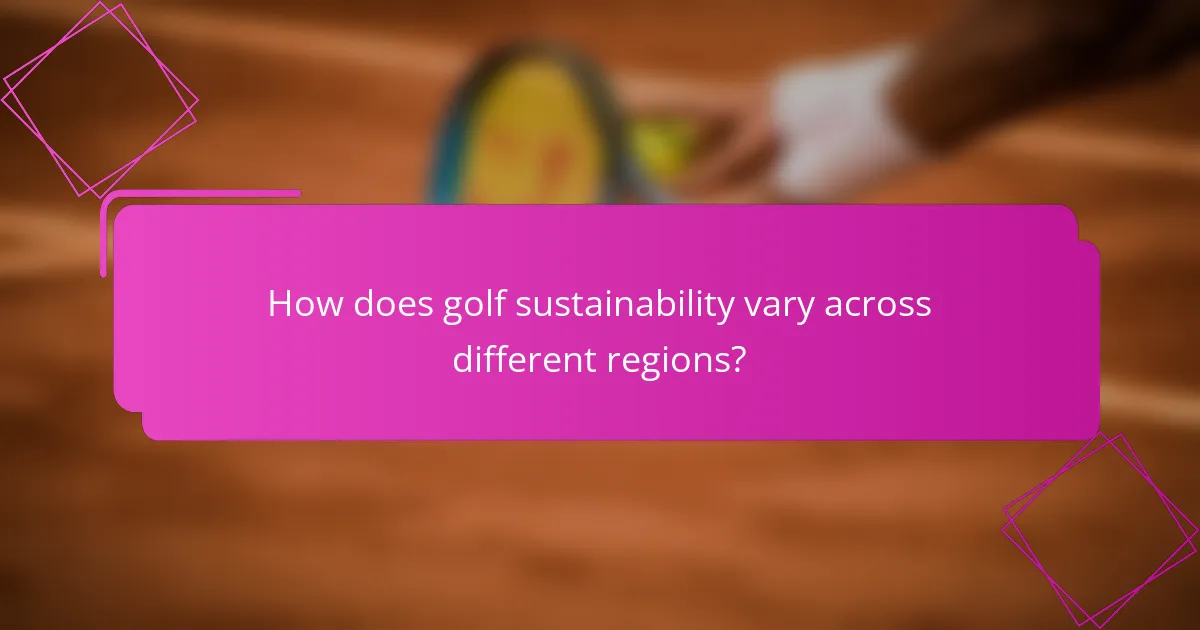
How does golf sustainability vary across different regions?
Golf sustainability varies significantly across regions due to local environmental conditions, cultural values, and regulatory frameworks. In the United States, many golf courses adopt water conservation techniques, such as drought-resistant grass and efficient irrigation systems. Conversely, in Europe, there is a stronger emphasis on organic maintenance practices and biodiversity initiatives, reflecting stricter environmental regulations.
In Asia, golf sustainability often focuses on community engagement and eco-tourism, promoting local culture alongside environmental stewardship. For example, courses in Japan integrate traditional landscaping with sustainable practices. In Australia, the unique climate drives innovations in waste management and renewable energy use on courses.
Regional differences also manifest in the adoption of technology. North American courses frequently utilize data analytics for resource management, while European courses may prioritize traditional methods to enhance ecological balance. Overall, the commitment to sustainability in golf is influenced by local priorities, leading to diverse practices and outcomes.
What unique sustainability challenges do golf courses in urban areas face?
Urban golf courses face unique sustainability challenges such as land use conflicts, water scarcity, and pollution management. These courses often compete with housing and commercial development, limiting available green space. Water shortages intensify the need for efficient irrigation practices, while urban runoff can lead to contamination of nearby waterways. Additionally, managing pesticide and fertilizer use is crucial to minimize environmental impact.
Which innovative solutions are being adopted in rural golf courses?
Rural golf courses are adopting innovative solutions focused on sustainability and community engagement. These practices include rainwater harvesting systems, solar energy installations, and organic turf management.
Additionally, many courses are implementing community programs that promote local biodiversity and conservation efforts. For instance, native plant landscaping reduces water usage and maintenance costs.
The integration of technology, such as smart irrigation systems, enhances resource efficiency. These advancements not only support ecological health but also improve the overall golfing experience.
By prioritizing eco-friendly practices, rural golf courses contribute positively to their communities and the environment, aligning with a growing trend towards sustainability in sports.
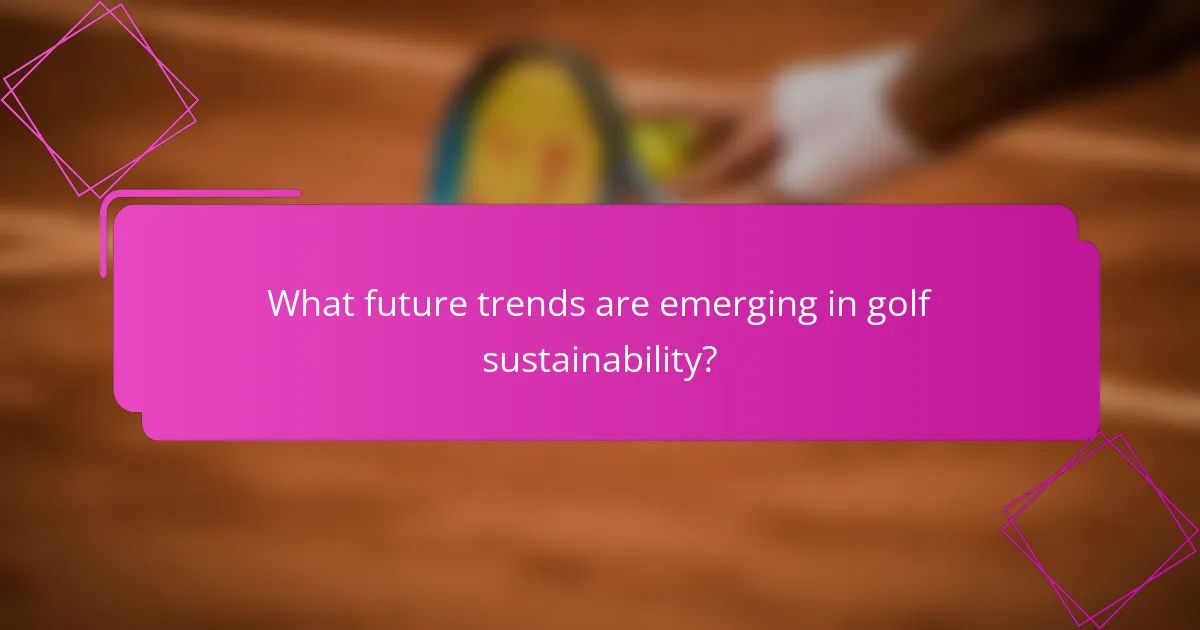
What future trends are emerging in golf sustainability?
Emerging trends in golf sustainability focus on innovative eco-friendly practices, community engagement, and technology integration. Courses increasingly adopt renewable energy sources, such as solar panels, to reduce carbon footprints. Water conservation techniques, like smart irrigation systems, are gaining traction to optimize resource use. Additionally, many golf clubs are implementing native landscaping to enhance biodiversity and reduce maintenance costs. Community initiatives, such as local partnerships for environmental education, foster greater awareness and participation in sustainability efforts. As a result, golf’s commitment to sustainability is strengthening, appealing to environmentally conscious players and stakeholders.
How is technology shaping sustainable practices in golf?
Technology is significantly enhancing sustainable practices in golf by optimizing resource management and reducing environmental impact. Innovations such as smart irrigation systems minimize water usage, while GPS technology helps in efficient course maintenance. Solar energy solutions power facilities, decreasing reliance on non-renewable resources. Additionally, eco-friendly materials in course design promote biodiversity and reduce waste. Many golf clubs are adopting these technologies, demonstrating a commitment to sustainability and community engagement.
What role do players and consumers play in promoting sustainability in golf?
Players and consumers play a crucial role in promoting sustainability in golf by adopting eco-friendly practices and supporting community initiatives. Their choices impact environmental conservation and influence industry standards.
Players can advocate for sustainable practices by choosing courses that prioritize eco-friendly maintenance, such as using organic fertilizers and conserving water. Additionally, they can participate in local clean-up events and support organizations dedicated to environmental stewardship.
Consumers contribute by demanding sustainable products, from golf equipment made with recycled materials to apparel produced under fair labor conditions. Their purchasing decisions encourage brands to adopt greener practices and invest in sustainable technologies.
Both players and consumers can foster a culture of sustainability by promoting awareness through social media and community engagement, ultimately leading to a more environmentally responsible golf industry.
What are the best practices for golf courses looking to enhance their sustainability efforts?
Golf courses can enhance sustainability by implementing practices like water conservation, native landscaping, and organic maintenance. These efforts reduce environmental impact and promote biodiversity. Engaging the community through educational programs further strengthens local support. Collaborating with environmental organizations can provide valuable resources and expertise.
